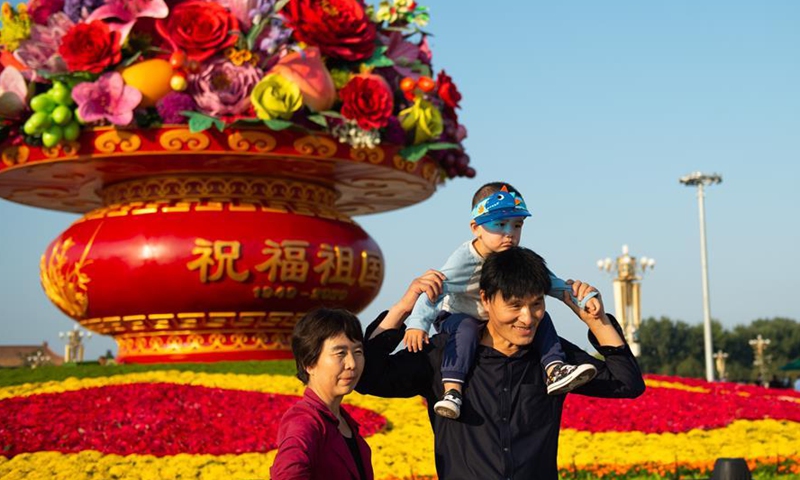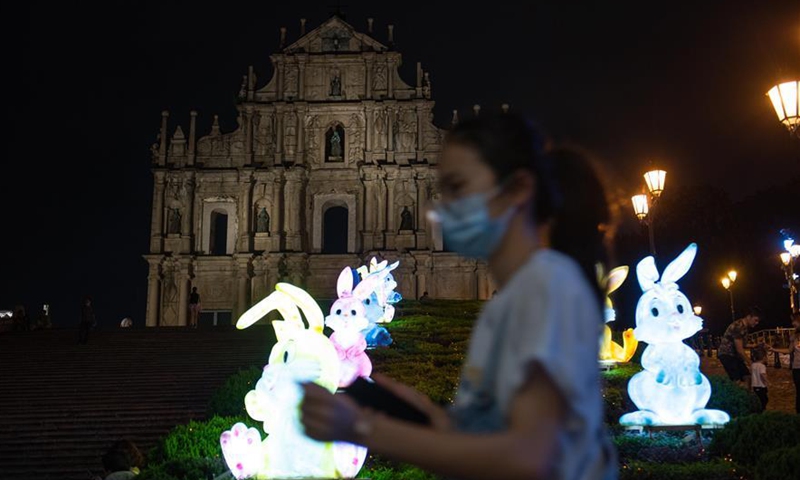Tourism boom in ‘Golden Week’ empowers China’s economic recovery
By Shen Weiduo and Chen Qingqing Source: Global Times Published: 2020/9/28 20:48:18 Last Updated: 2020/9/28 22:19:27
Outbound tourism unlikely to recover in two years over pandemic concerns: analyst

Tourists pose for photos in front of a "flower basket" at Tian'anmen Square in Beijing, capital of China, Sept. 24, 2020. The 18-meter-tall display in the shape of a flower basket is placed at the center of Tian'anmen Square as a decoration for the upcoming National Day holiday.Photo:Xinhua
As the pandemic continues to cast a shadow on many countries and regions around the world, China quietly welcomes its eight-day National Day holidays starting Thursday.
The country's tourism industry is more than thrilled to see what they believe could be the "busiest ever" holiday season since the COVID-19 outbreak, as travelers in the world's largest outbound-travel source market all flocked back and may further empower China's consumption and economic rebound in the post-epidemic era.
"After more than half a year of prevention work and epidemic control, the holidays will see a truly 'national movement,' thus the meaning for the industry goes without saying, and everyone in the industry has prepared for the holidays, whether it is in product research, promotion or security assurance," Xu Xiaolei, manager of marketing at China's CYTS Tours, told the Global Times on Monday.
Since holiday ticket bookings started from the beginning of September, domestic residents have been in strong demand for holiday travel, said industry players. China is expected to record 550 million domestic tourists during the upcoming eight-day Mid-Autumn Festival and National Day holiday season, said the Ministry of Culture and Tourism on Sunday.
China's state railway operator said on Monday that it expects to handle 108 million passenger trips during the 11-day travel peak of the National Day holidays, an average of 9.82 million trips per day.
The railway operator said that Thursday, China's National Day, will see the peak of passenger flow, with an estimated amount of 13 million trips - setting a new high in the daily average passenger flow on the railways since the outbreak of COVID-19 began.
Meanwhile, China's domestic flights are also expected to push past pre-COVID levels. Global travel data and analytics outfit Cirium said in a statement sent to the Global Times that more than 164,700 domestic flights were scheduled during the period, an increase of more than 11 percent, compared with the same time in 2019 when approximately 148,000 flights flew.
"I have been waiting for the holidays for months; the eight-day holidays are also perfect for my planned trip to Daocheng Yading, the famous scenic spot in Chengdu, Southwest China's Sichuan Province," Chen Xiaoying, a white-collar worker who is employed by a real estate firm in Shanghai, told the Global Times on Monday, noting that almost all her friends have travel plans for the holidays since they've been "cooped up" for such a long time.
According to the survey results that Rong360 Jianpu Technology sent to the Global Times, respondents who have planned to travel during the National Day holidays account for more than 60 percent of the total, increasing significantly over the first half; more than half of the respondents would like to scale up their budget for the National Day holidays, presenting good prospects for the tourism market.
With the expected consumption explosion in almost "all sectors," experts said the booming tourism market is expected to further drive the economic recovery in the world's second-largest economy, and inject fresh momentum to the world's post-pandemic recovery while some others were still caught up in the rampant rise of COVID-19 cases.

Illumination installations are seen in front of the Ruins of the St. Paul's in Macao, south China, Sept. 25, 2020. Main streets, squares, gardens and buildings in Macao are decorated with illuminations to celebrate the upcoming Mid-Autumn Festival and the National Day holiday.Photo:Xinhua
Cautious reopening
Despite a "travel carnival" being likely to remerge during the Golden Week holidays, industry players cautioned that a full recovery is still on the way, and the whole industry is still taking a cautious attitude and a series of strict epidemic-control measures in fear of a COVID-19 resurgence.
"The pandemic still remains the biggest challenge faced by the tourism market," Benson Bao, general manager of a travel agency mainly engaging in Europe travel, told the Global Times on Monday, adding that if the pandemic could be put under control during this fall and winter, the domestic tourism industry is expected to achieve a full recovery in February, China's Spring Festival, next year.
Public willingness to travel during this National Day holiday season has "declined significantly" compared with the previous years, according to the survey from Rong360 Jianpu Technology.
In such a context, it still takes time for the tourism market to fully recover, and the trend of the pandemic at home and abroad will influence the development of the tourism industry in the long run, the survey found.
"We will still keep the number of tourists under 75 percent of the maximum carrying capacity of tourist spots," Xu Wanfu, tourism bureau chief of Zhangye, a tourist city in Northwest China's Gansu Province, told the Global Times on Monday, noting that all tourist attractions and performances across the city will adopt strict epidemic-prevention measures.
Personnel control, ensuring vacancy rates, frequent disinfection, and body temperature checks are still "rigid requirements"from local tourism authorities, several industry players told the Global Times.
While local authorities in major cities are guarding up against potential sporadic coronavirus cases, some medical experts believed that China has accumulated substantial experience in resuming production and social activities while maintaining normal epidemic prevention work.
Yang Zhanqiu, deputy director of the pathogen biology department at Wuhan University who closely observes epidemic control work since the COVID-19 outbreak in China began, said central and local governments have been fully prepared for emergencies.
But the past experiences in handling sporadic cases strengthened public confidence in dealing with them, especially when there has been no domestically transmitted case for more than a month, Yang told the Global Times on Monday.
Following COVID-19 resurgences in Dalian in Northwest China's Liaoning and in Urumqi in Northwest China's Xinjiang Uygur Autonomous Region having been eliminated in August, China has seen zero domestically transmitted cases for about a month until Qingdao in East China's Shandong Province reported two asymptomatic patients lately. Still, China faces the challenging task of fending off imported infections as several countries including the UK and the US have been recording spikes in new cases in recent weeks with schools and businesses reopening.
"As long as the country does not relax its restrictions on travel abroad, it's impossible that China will see a massive rebound in coronavirus cases in the coming months," Yang said.
Frozen outbound tourism
Experts cautioned that considering the grave COVID-19 pandemic situation overseas, suspended outbound tourism is still necessary as the total coronavirus cases worldwide have surpassed 32 million.
The Chinese Foreign Ministry also reminded citizens on Monday that Chinese people traveling abroad should be cautious and shouldn't travel unless it's necessary during the upcoming eight-day Mid-Autumn Festival and National Day holidays.
"Outbound tourism is still unlikely to recover for at least one to two years, or as long as four years as some other industry players pointed out," Bao said, noting that mass-scale vaccination may be the only turning point for a full recovery of overseas travel.
Xu noted that China's tourism recovery could also offer a path to their foreign counterparts. "A basic experience at its core is to first realize prevention and control of the epidemic, and restore social production and development order as much as possible."
"However, one should realize the orderly opening of the tourism industry in a step-by-step manner instead of all at once. If you look at China's measures from the very beginning, we first keep tourist numbers below 30 percent of the reception capacity, then 50 percent, and now at about 80 percent," Xu said.
Posted in: SOCIETY